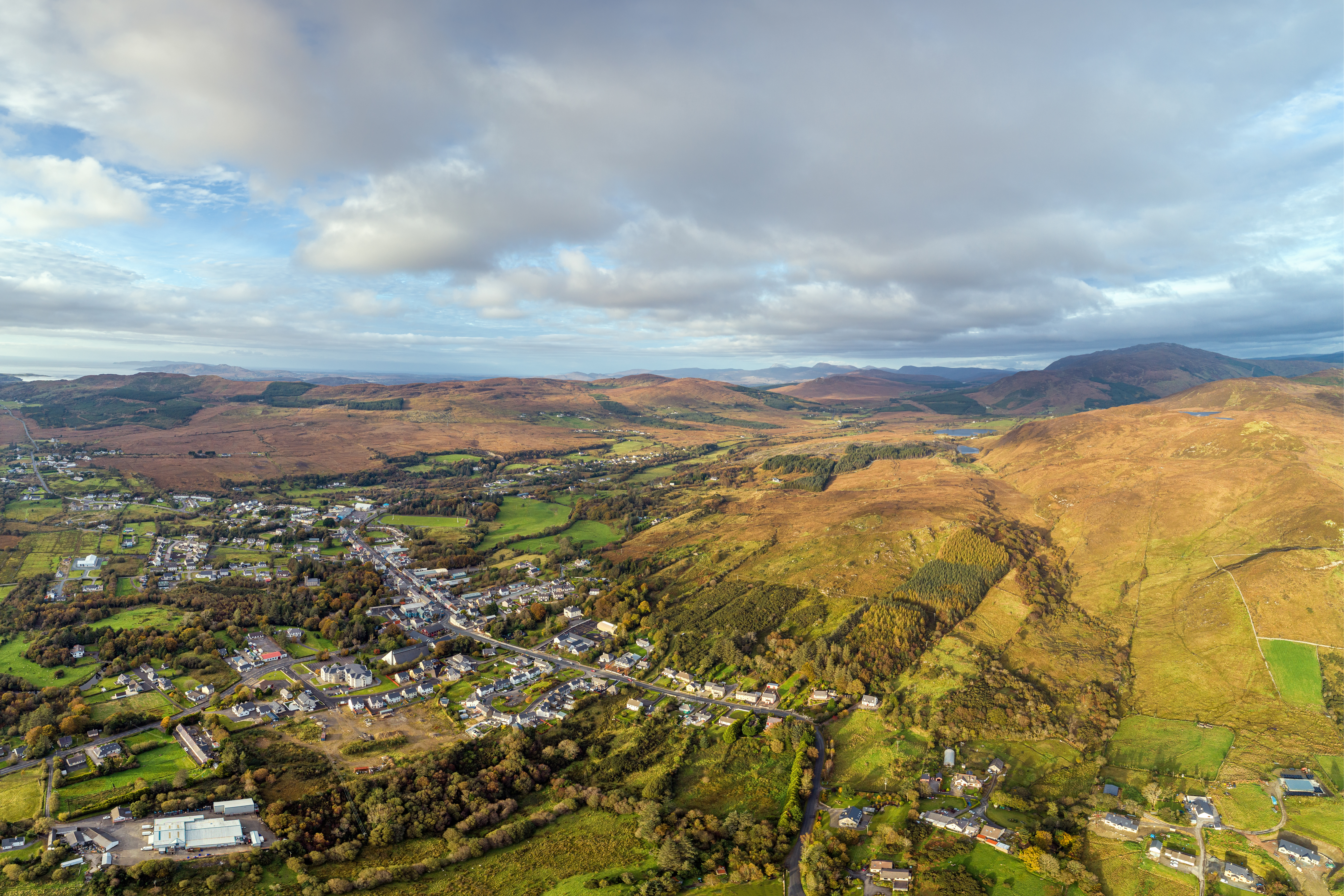Brian Friel’s Donegal: A Landscape of Memory and Magic
Explore the deep connections between one of the world’s greatest modern playwrights and a part of Ireland, famed for its rugged landscapes and rich traditions.

Glenties, Co Donegal
High up in a quiet graveyard in rural Donegal lies the final resting place of one of Ireland’s finest playwrights. At Glenties cemetery, a simple, dark slab marks the grave of Brian Friel, who died at the age of 86 ten years ago this year.
Below the graveyard stretches a patchworked landscape dotted with trees, farms and cottages. In the distance, the Bluestack Mountains rest quietly. This is Friel’s land: Glenties. It’s where his mother Mary MacLoone was born, where Friel spent his childhood summers, and which he transformed in his writing into “Ballybeg”. In its Irish translation, Ballybeg means “Baile Beag”, or “little town”.
Small in name but vast in influence, Ballybeg echoes throughout Friel’s greatest works. We journey through Ballybeg in Dancing at Lughnasa (1990), widely hailed as Friel’s masterpiece; in Faith Healer (1979), named one of the greatest plays of all time by The Independent; and in Translations (1980), which explores clashes over language and culture in 19th-century Ireland.
Place is central to Friel’s work, says David Grant, senior lecturer in Drama at the School of Arts, English and Languages in Queen’s University Belfast. “I think that's probably the strongest way of expressing Brian Friel’s connection with Donegal – that it came to be the home place, the place where there was a sense of belonging,” he says.
Grant once took students who were staging a production of Translations on a trip around the Inishowen peninsula, to help them understand the connection between Friel’s work and Donegal. “They came away with such a stronger sense of what the play was about: that sense of connection between ocean and mountain and land,” says Grant. “It all comes back to that rootedness, that sense of being almost rooted in the soil of the place.”
-2.jpg?sfvrsn=1b681577_1)
Storm Ciara, Gweedore, Co. Donegal
A Place of Memory and Myth
Born in County Tyrone, Friel moved with his family to Derry~Londonderry in 1939. By the 1950s, he had begun his writing career, and his first full-length stage play, The Enemy Within, premiered in Ireland’s national theatre, the Abbey Theatre, in 1962. Growing up, his family spent summers in his mother’s hometown of Glenties, and in the 1960s, Friel made his home in Greencastle, a small fishing town about a 90-minute drive away.
While much of Friel’s work is influenced by his life and heritage, it’s Dancing at Lughnasa that is considered his most autobiographical play. Set during Lughnasa – an ancient Celtic festival that marks the beginning of the harvest season – it focuses on the Mundy sisters, who were inspired by Friel’s mother and her sisters. The sisters had grown up in Laurels Cottage, which is now owned by the Brian Friel Centre and has been earmarked as a visitor centre. The play is dedicated to “those five brave Glenties women”.
When Dancing at Lughnasa was made into a film in 1998, there was only one place it could be filmed: Glenties. Its star, Meryl Streep, told the Irish public service broadcaster RTÉ of “an especially wonderful moment up in Donegal where we were in a town and the kids got up at a school and they danced for us. We’d had a little Guinness as well on the way in – it was one of the most magical afternoons of my life.”

Errigal Mountain, Co. Donegal
The Splendour of Donegal
Friel once said that his memories of summer holidays in Glenties are “as intense as if they happened last week”. Donegal truly does cast a spell on visitors. Winding your way through the rugged and verdant countryside, it often feels like you have only the rolling hills for company. And yet there’s so much life in Donegal, with the people key to making trips here unforgettable. The local pubs are hives of music, chat and storytelling, and traditional crafts, such as tweed making, are flourishing.
In Glenties, keep an eye out for hands-on events such as willow basket-making workshops. Or pop into St Connell’s Museum and Heritage Centre on Mill Road, named after St Connell Caol, who founded a monastery on nearby Inishkeel Island in the 6th century. Inside, local history is told through unique artefacts and memorabilia, as well as collections related to Friel and fellow writer Patrick McGill.
The area’s appeal is accentuated by great places to stay that allow visitors the chance to enjoy a slower pace of life. The Highlands Hotel in the heart of Glenties town offers easy access to walking routes, such as the Bluestack Way. The hotel even provides packed lunches for those who want to take a long ramble and let go of some of life’s stresses and strains.
In nearby Fintown, you’ll find the Bird Box, a handcrafted treehouse for two with a cosy bedroom and views of the stunning Glenveagh National Park. Nature also takes centre stage at the Hide at Neadú, an intimate cabin offering optimum views of both Glenveagh and the rugged Derryveagh Mountains. Thanks to its wood-burning stove, it’s a delightful spot to stay year-round for a secluded but comfy trip.
For a taste of the Gaeltacht – where, as in Friel’s play Translations, the Irish language is spoken – head to Gweedore, a 40-minute drive from Glenties. This is a town alive with culture and tradition, and is the largest Irish-speaking district in Ireland. The Amharclann Ghaoth Dobhair theatre here offers everything from music sessions to musicals. There are beautiful beach walks and exceptional sights, such as the derelict Old Church of Dunlewey at the foot of Errigal, in what is known as the Poisoned Glen.

Fintown Railway, Co. Donegal.
FrielDays – A Celebration of Friel
In 2025, a highlight on Ireland’s cultural calendar is FrielDays – A Homecoming (2025–2029), curated by Arts Over Borders. This theatrical celebration of Friel and his works, building to the centenary of the great playwright’s birth, will present performances of 29 plays across the northwest counties of Donegal, Tyrone, and Londonderry.
Events begin in August, with five of Friel’s most significant plays staged in the places that inspired them. For example, Dancing at Lughnasa will be performed at St Columba’s School in Glenties, near Laurels Cottage. Translations will take place in the Gaeltacht region of Dunlewey. Faith Healer, meanwhile, will be performed in three community halls and a hotel in west Donegal.
The site-specific plays will also be performed at the time of year in which they are set, linking them into Irish calendar traditions like Lughnasa. There will be Irish-speaking actors, seanchaí storytellers and community-led festivals to add more enrichment to the FrielDays programme.
Meanwhile, more Friel celebrations can be found when Dublin’s 3Olympia venue hosts the acclaimed Gate Theatre production of Dancing at Lughnasa from 27 June to 26 July.
Friel rarely spoke of himself, preferring to let his work speak volumes. And through it, Donegal speaks too - a place of profound feeling, enduring stories, and quiet wonder.
